Producing Agarwood Oil In Thailand
In January, 2009, my friend Stephen V. Dowthwaite, founder of PerfumersWorld, Ltd. of Bangkok, Thailand, visited a Thai agarwood oil producer near the Cambodian border and sent me the photos which appear on this page with permission to use them here. The captions under the photos are taken from Steve's notes to me. No doubt he will share more about this experience in his 5-Day Perfumery Workshops.
In the article below I have provided some additional information on agarwood and agarwood oil production.
— Philip Goutell
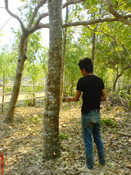
Agarwood oil goes by many names — eaglewood ... aloeswood ... oud ... oudh ... oodh ... chen xiang ... pan d'aguila ... bois d'aigle ... adlerholz — to name just a few. Agarwood oil is particularly prized in Asia and the Middle East but occasionally finds its way into a Western perfume such as M7 by Yves Saint Laurent.
Depending on the quality, Agarwood Oil can range in price from about $8,000 to $20,000 per kilo. Even at the $8,000 level and above, adulteration with non-agarwood materials is almost a certainty and it is estimated that 90 percent of the Agarwood Oil on the market has been adulterated with non-agarwood materials.
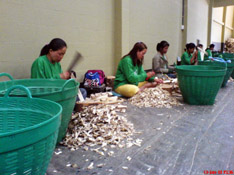
Sustainable Production
Ironically, it is this oleoresin produced by infected trees that makes the agarwood tree valuable. The desired fragrance is in the fungus-fighting oleoresin and it can be released through distillation of chips of the infected wood. Uninfected trees cannot produce Agarwood Oil.
While the aroma of Agarwood is not well known in Europe and the Americas, it is a favorite fragrance for joss sticks, particularly in India. In Middle Eastern countries Agarwood Oil finds use in both attars and perfumes. The fragrance is a complex woody aroma which can easily be described as "exotic" or "oriental."
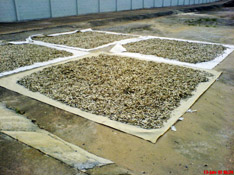
Traditionally Agarwood Oil was produced from infected trees growing wild in forests. Even today the top grades of Agarwood Oil are harvested from trees in the wild. But deforestation and non-sustainable harvesting of forest grown trees has led to greater environmental awareness and the rise of sustainable Agarwood Oil production through the use of nursery grown agarwood trees and artificial methods of infecting them.
The rising price of Agarwood Oil had led to a boom in the planting of agarwood trees as an investment, but for many investors, the investment in agarwood trees has been of questionable value as the agarwood produced from nursery grown trees has yet to match the quality — and value — of Agarwood Oil produced from older, forest grown trees.
Production Methods
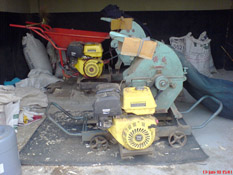
In the forest, the agarwood tree may become fungus-infected by natural means. But for communities living near agarwood forests, techniques have been developed to help nature along and thus provide a more stable source of income for these communities. The methods used to infect agarwood trees are closely guarded secrets.
Nursery grown agarwood trees must also be infected — by nursery workers — and again, the exact methods whereby they accomplish this are closely guarded secrets.
Once patches of the tree have darkened with the infection-fighting oleoresin, the wood is harvested and the darkened sections of wood are chipped off the logs for oil production. The undarkened wood has no value in the fragrance industry.
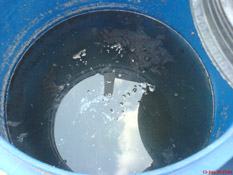
After the chips of infected agarwood have ben left in the sun to dry for a day or two they are gathered up and put through a mechanical chipper which reduced them almost to sawdust.
These sawdust-like "chips" are now soaked in water in barrels and allowed to "ferment" for ten to fifteen days. Starting off a light brown, they gradually darken, giving off a foul aroma.
The agarwood mash is now placed in distilling pots and covered with several inches of water. The lid is closed and the pot heated until the water boils. The boiling water ruptures the cells of the wood and the vapor of Agarwood Oil and steam rises to the top of the pot and escapes released through a tube leading to a condenser which cools the vapor. The condenser itself is repeatedly cooled by water.
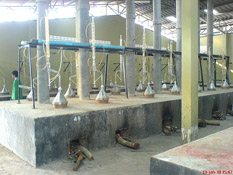
As the vapor passes through the condenser and is cooled, it reverts to liquid form and is collected in a vessel where the oil and water separate. (Oil and water don't mix!) The water is drawn off leaving Agarwood Oil.
Several distillations will generally occur with the first producing the highest grade of Agarwood Oil and the last, the lowest. These distillations may continue over a week's time.
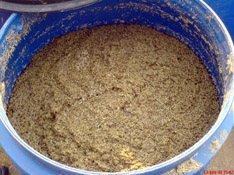
Before being bottled, the Agarwood Oil is filtered to remove dirt and impurities.
The residue from the distilling pot is now dried in the sun for several days before being crushed into powder for joss stick (incense) production.
Part I: Making Your Own Perfume For Pleasure or for Profit
Homemade perfumes generally lack commercial value, regardless of how wonderful they may be, because their creators fail to record how their perfumes were made. To profit from a perfume, to sell it, to sell the rights to it, or have somebody sell it for you, you must be able to make more of it. To make more you need the formula, the record of how the perfume was made: what materials were used and how much of each material was used. While the formula is nothing more than a recipe, a simple piece of paper, it is the key to unlocking your perfume's commercial potential. With the formula in your hand you have the ability to make a few dozen bottles more or, like the celebrities, tens of thousands of bottles. How to create an international production formula for your homemade perfume is a guide to getting you started on the right foot, correctly documenting everything you do as you are doing it, and then using these notes with some basic mathematics to write a simple, accurate, universal formula for your perfume. Writing formulas for your perfumes can change the way you think about them. With your formulas in hand your creations are no longer "here today, gone tomorrow." Now, thanks to your library of formulas, your perfumes become immortal!
While much is written about perfume – the beautiful fragrances... the beautiful bottles – little is available on the "mechanics" of perfume production – the steps that take place on the "factory floor" where a beautiful vision is turned into a finished product, a "ready to sell" perfume. Now you can experience all of these steps, hands on, by making just one quart of your own perfume. If you follow each chapter and do what you are instructed to do, you will end up with from 8 to 64 bottles of your own perfume, depending on the capacity of the bottles you select. Along this "insiders journey," each step is profusely illustrated with professional color photographs and you'll learn — • Exactly what alcohol you'll need and where to get it • Why you'll want (just a little!) water in your perfume • What type bottles you'll need and why you cannot use others • Why you will use a spray and not a cap • How to fill and seal your bottles • How to label your bottles with the correct information so they will be legal for sale • How to select a name for your perfume that will allow you to acquire powerful trademark rights free. If you are a developer of scents you are encouraged to use one of your own for this project. If you are not a scent creator yourself you'll learn how to get a fragrance oil that is exactly right for this project. Online sources are given for all required supplies and materials. Nothing can hold you back from starting your project immediately!
Perfume is famous for the markup it can achieve, even for a middle market fragrance. While "everybody knows" that perfume costs next to nothing to make (not completely true) the making of it is often considered an esoteric secret. "Creating Your Own Perfume With A 1700 Percent Markup!" details how a 3-person company with no experience created their own fragrance in response to a marketing opportunity that was too good to pass up. The book explains exactly what was done to create a fragrance for that opportunity but it is far more than a history of the author's project. "Creating Your Own Perfume With A 1700 Percent Markup!" lays out every step in the process of creating your own perfume, either as a do-it-yourself project – and without the benefit of automated equipment some compromises and workarounds are required – or full bore professional production under your supervision. Either way you will be producing a quality fragrance at a remarkably low cost. Do you have a marketing opportunity that would be wildly profitable if only you could obtain your fragrance at a ridiculously low cost? "Creating Your Own Perfume With A 1700 Percent Markup!" is the guide you need to do it.
A really great name, a special name that is just right for a particular perfume or perfume marketer (or entrepreneur with money to invest!) can be worth a ton of money. But few individuals with great ideas ever manage to cash in on those brilliant ideas. Instead they wait while others "discover" their idea, acquire legal rights to it and make all the money while they are left out in the cold without a penny having been earned for what was once THEIR idea.
If you are struggling to name your perfume and are looking for a name that will have real value, "Naming Your Perfume And Protecting Your Name" will help you weed out low value names and point you to names that have better marketing value plus the potential to become valuable assets in themselves.
If you have a great name you want to protect but no fragrance, "Naming Your Perfume And Protecting Your Name" will guide you through the simple steps you must take to acquire a legal right to that name before someone else grabs it! Best of all, "Naming Your Perfume And Protecting Your Name" shows you how to gain strong legal protection for your name without a lawyer and without spending more than pocket change.
Never had an idea for a product name? Never thought much about perfume? "Naming Your Perfume And Protecting Your Name" may stimulate your interest in a whole new game that, when played well, can make you lots of money without your having to leave the comfort of your home office.
You can build a perfume business of your own using this business plan as a guide. By following its detailed strategy you learn to identify motivated groups of potential perfume buyers. Members of these groups are near the tipping point of desire for a new perfume. You don't know these people and they don't know you but you know a marketer they trust, one who does not currently sell perfume and might never think of selling perfume were it not for your approach. Here is where you step in with a professional plan, promotion, and perfume to take advantage of this ripe opportunity for mutual profit. Before your first promotion has peaked, you will already be developing a relationship with your next marketing partner. Following this plan, you will gain more and more profit with each new marketing partnership.
Now when you make your own perfume you can make it fully "commercial" meaning you will be creating a product ready for regular, continuous sales to friends, relatives, and the public! If the fragrance you've made has already won praise, why not share it with others? Some might pay you for it and want it for their web stores or retail boutiques! Creating your own perfume from dropper bottles: Methods, mechanics, and mathematics guides you through steps that can turn your hobby project into a perfume business. Discover how close you are now and how little more you must do to take what you made with essential oils and dropper bottles into a business of your own! For an introduction to this book, watch this video.
When you name a perfume you create a valuable asset – the name itself. To sell your perfume you want the most effective name possible. But a good name can have value beyond the edge it gives your sales. In naming your fragrance you are creating a trademark and a trademark can have value independent of the product. The value of that trademark can vary. Much depends on how well, in naming your perfume, you follow the trademark "rules." How To Create A More Valuable Name For Your Perfume first helps you develop a name that will be effective in selling your perfume. It then prods you to make use of certain techniques that can turn a good name into a great trademark, strong and valuable. If you have questions about how to protect a name, How To Create A More Valuable Name For Your Perfume will answer many such as:
- Can you protect your name yourself or do you need a lawyer?
- Can you register a trademark without a lawyer?
- What does it cost to register a trademark?
- How do I enforce the rights I have established?
How To Create A More Valuable Name For Your Perfume covers both state, federal, and international protection.
For article updates, etc., add your name to Phil's mailing list.


Philip Goutell
Lightyears, Inc.








